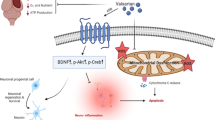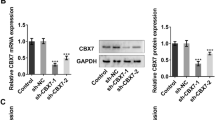Abstract
Neuron-specific conventional protein kinase C (cPKC)γ mediates cerebral hypoxic preconditioning (HPC). In parallel, autophagy plays a prosurvival role in ischemic preconditioning (IPC) against ischemic stroke. However, the effect of cPKCγ on autophagy in IPC still remains to be addressed. In this study, adult and postnatal 1-day-old C57BL/6 J wild-type (cPKCγ+/+) and knockout (cPKCγ−/−) mice were used to establish in vivo and in vitro IPC models. The results showed that IPC pretreatment alleviated neuronal damage caused by lethal ischemia, which could be suppressed by autophagy inhibitor 3-MA or bafilomycin A1. Meanwhile, cPKCγ knockout blocked IPC-induced neuroprotection, accompanied by significant increase of LC3-I to LC3-II conversion and Beclin 1 protein level, and a significant decrease in p62 protein level. Immunofluorescent staining results showed a decrease of LC3 puncta numbers in IPC-treated cPKCγ+/+ neurons with fatal ischemia, which was reversed in cPKCγ−/− neurons. In addition, cPKCγ-modulated phosphorylation of mTOR at Ser 2448 and ULK1 at Ser 555, rather than p-Thr-172 AMPK, was detected in IPC-pretreated neurons upon lethal ischemic exposure. The present data demonstrated that cPKCγ-modulated autophagy via the mTOR-ULK1 pathway likely modulated IPC-induced neuroprotection.







Similar content being viewed by others
Data Availability
The data that support the findings of this study are available from the corresponding authors upon reasonable request.
Abbreviations
- cPKCγ:
-
Conventional protein kinase Cγ
- IPC:
-
Ischemic preconditioning
- MCAO:
-
Middle cerebral artery occlusion
- OGD:
-
Oxygen-glucose deprivation
- HBSS:
-
Hanks’ balanced salt solution
- DMEM:
-
Dulbecco’s modified Eagle’s medium
- 3-MA:
-
6-Amino-3-methylpurine
- Baf A1:
-
Bafilomycin A1
- MTT:
-
3-(4,5-Dimethylthiazol-2-yl)-2,5-diphenyltetrazolium bromide
- DAPI:
-
4′6-Diamidino-2-phenylindole
- DMSO:
-
Dimethyl sulfoxide
- SDS-PAGE:
-
Sodium dodecyl sulfate–polyacrylamide gel electrophoresis
- LC3:
-
Microtubule-associated protein 1 light chain 3
- SQSTM1/p62:
-
Sequestosome 1
- mTOR:
-
Mechanistic target of rapamycin
- ULK1:
-
Unc-51 like autophagy activating kinase
- AMPK:
-
5’-Monophosphate-activated protein kinase
- HSP60:
-
Heat shock protein 60
- Tom20:
-
Translocase of the outer mitochondrial membrane 20
References
Hao Y, Xin M, Feng L, Wang X, Wang X, Ma D, et al. Review cerebral ischemic tolerance and preconditioning: methods, mechanisms, clinical applications, and challenges. Front Neurol. 2020;11:812.
Li S, Hafeez A, Noorulla F, Geng X, Shao G, Ren C, et al. Preconditioning in neuroprotection: from hypoxia to ischemia. Prog Neurobiol. 2017;157:79–91.
Vinciguerra A, Cuomo O, Cepparulo P, Anzilotti S, Brancaccio P, Sirabella R, et al. Models and methods for conditioning the ischemic brain. J Neurosci Methods. 2018;310:63–74.
Saito N, Shirai Y. Protein kinase C gamma (PKC gamma): function of neuron specific isotype. J Biochem. 2002;132(5):683–7.
Zhang N, Yin Y, Han S, Jiang J, Yang W, Bu X, et al. Hypoxic preconditioning induced neuroprotection against cerebral ischemic injuries and its cPKCγ-mediated molecular mechanism. Neurochem Int. 2011;58(6):684–92.
Eskelinen EL. Autophagy: supporting cellular and organismal homeostasis by self-eating. Int J Biochem Cell Biol. 2019;111:1–10.
Shi Q, Cheng Q, Chen C. The role of autophagy in the pathogenesis of ischemic stroke. Curr Neuropharmacol. 2021;19(5):629–40.
Ajoolabady A, Wang S, Kroemer G, Penninger JM, Uversky VN, Pratico D, et al. Targeting autophagy in ischemic stroke: from molecular mechanisms to clinical therapeutics. Pharmacol Ther. 2021;225: 107848.
Wang P, Shao BZ, Deng Z, Chen S, Yue Z, Miao CY. Autophagy in ischemic stroke. Prog Neurobiol. 2018;163–164:98–117.
Sheng R, Liu XQ, Zhang LS, Gao B, Han R, Wu YQ, et al. Autophagy regulates endoplasmic reticulum stress in ischemic preconditioning. Autophagy. 2012;8(3):310–25.
Park HK, Chu K, Jung KH, Lee ST, Bahn JJ, Kim M, et al. Autophagy is involved in the ischemic preconditioning. Neurosci Lett. 2009;451(1):16–9.
Yan L, Sadoshima J, Vatner DE, Vatner SF. Autophagy in ischemic preconditioning and hibernating myocardium. Autophagy. 2009;5(5):709–12.
Livingston MJ, Wang J, Zhou J, Wu G, Ganley IG, Hill JA, et al. Clearance of damaged mitochondria via mitophagy is important to the protective effect of ischemic preconditioning in kidneys. Autophagy. 2019;15(12):2142–62.
Zhang D, Han S, Wang S, Luo Y, Zhao L, Li J. cPKCγ-mediated down-regulation of UCHL1 alleviates ischaemic neuronal injuries by decreasing autophagy via ERK-mTOR pathway. J Cell Mol Med. 2017;21(12):3641–57.
Zhang Y, Ying G, Ren C, Jizhang Y, Brogan D, Liu Z, et al. Administration of human platelet-rich plasma reduces infarction volume and improves motor function in adult rats with focal ischemic stroke. Brain Res. 2015;1594:267–73.
Zheng J, Wang Y, Liu Y, Han S, Zhang Y, Luo Y, et al. cPKCγ deficiency exacerbates autophagy impairment and hyperphosphorylated Tau buildup through the AMPK/mTOR pathway in mice with type 1 diabetes mellitus. Neurosci Bull. 2022. Advance online publication. https://doi.org/10.1007/s12264-022-00863-4.
Xiang H, Zhang J, Lin C, Zhang L, Liu B, Ouyang L. Targeting autophagy-related protein kinases for potential therapeutic purpose. Acta Pharm Sin B. 2020;10(4):569–81.
Li J, Niu C, Han S, Zu P, Li H, Xu Q, et al. Identification of protein kinase C isoforms involved in cerebral hypoxic preconditioning of mice. Brain Res. 2005;1060(1–2):62–72.
Kabeya Y, Mizushima N, Ueno T, Yamamoto A, Kirisako T, Noda T, et al. LC3, a mammalian homologue of yeast Apg8p, is localized in autophagosome membranes after processing. EMBO J. 2000;19(21):5720–8.
Cao Y, Klionsky DJ. Physiological functions of Atg6/Beclin 1: a unique autophagy-related protein. Cell Res. 2007;17(10):839–49.
Feng Y, He D, Yao Z, Klionsky DJ. The machinery of macroautophagy. Cell Res. 2014;24(1):24–41.
Maejima Y, Isobe M, Sadoshima J. Regulation of autophagy by Beclin 1 in the heart. J Mol Cell Cardiol. 2016;95:19–25.
Pankiv S, Clausen TH, Lamark T, Brech A, Bruun JA, Outzen H, et al. p62/SQSTM1 binds directly to Atg8/LC3 to facilitate degradation of ubiquitinated protein aggregates by autophagy. J Biol Chem. 2007;282(33):24131–45.
Sheng R, Qin ZH. The divergent roles of autophagy in ischemia and preconditioning. Acta Pharmacol Sin. 2015;36(4):411–20.
Hausenloy DJ, Yellon DM. The second window of preconditioning (SWOP) where are we now? Cardiovasc Drugs Ther. 2010;24(3):235–54.
Dunlop EA, Tee AR. The kinase triad, AMPK, mTORC1 and ULK1, maintains energy and nutrient homoeostasis. Biochem Soc Trans. 2013;41(4):939–43.
Bach M, Larance M, James DE, Ramm G. The serine/threonine kinase ULK1 is a target of multiple phosphorylation events. Biochem J. 2011;440(2):283–91.
Wang Y, Zhang H. Regulation of autophagy by mTOR signaling pathway. Adv Exp Med Biol. 2019;1206:67–83.
Li Y, Chen Y. AMPK and autophagy. Adv Exp Med Biol. 2019;1206:85–108.
Pastore D, Pacifici F, Dave KR, Palmirotta R, Bellia A, Pasquantonio G, et al. Age-dependent levels of protein kinase Cs in brain: reduction of endogenous mechanisms of neuroprotection. Int J Mol Sci. 2019;20(14):3544.
Wei H, Li Y, Han S, Liu S, Zhang N, Zhao L, et al. cPKCγ-modulated autophagy in neurons alleviates ischemic injury in brain of mice with ischemic stroke through Akt-mTOR pathway. Transl Stroke Res. 2016;7(6):497–511.
Hua R, Han S, Zhang N, Dai Q, Liu T, Li J. cPKCγ-modulated sequential reactivation of mTOR inhibited autophagic flux in neurons exposed to oxygen glucose deprivation/reperfusion. Int J Mol Sci. 2018;19(5):1380.
Liu J, Liu W, Lu Y, Tian H, Duan C, Lu L, et al. Piperlongumine restores the balance of autophagy and apoptosis by increasing BCL2 phosphorylation in rotenone-induced Parkinson disease models. Autophagy. 2018;14(5):845–61.
Xu HD, Qin ZH. Beclin 1, Bcl-2 and autophagy. Adv Exp Med Biol. 2019;1206:109–26.
Yang YD, Li ZX, Hu XM, Wan H, Zhang Q, Xiao R, et al. Insight into crosstalk between mitophagy and apoptosis/necroptosis: mechanisms and clinical applications in ischemic stroke. Curr Med Sci. 2022;42(2):237–48.
Hirayama Y, Koizumi S. Astrocytes and ischemic tolerance. Neurosci Res. 2018;126:53–9.
McDonough A, Weinstein JR. The role of microglia in ischemic preconditioning. Glia. 2020;68(3):455–71.
Xiang J, Andjelkovic AV, Zhou N, Hua Y, Xi G, Wang MM, et al. Is there a central role for the cerebral endothelium and the vasculature in the brain response to conditioning stimuli? Cond Med. 2018;1(5):220–32.
He Z, Ning N, Zhou Q, Khoshnam SE, Farzaneh M. Mitochondria as a therapeutic target for ischemic stroke. Free Radic Biol Med. 2020;146:45–58.
Russo E, Nguyen H, Lippert T, Tuazon J, Borlongan CV, Napoli E. Mitochondrial targeting as a novel therapy for stroke. Brain Circ. 2018;4(3):84–94.
Lotz C, Herrmann J, Notz Q, Meybohm P, Kehl F. Mitochondria and pharmacologic cardiac conditioning-at the heart of ischemic injury. Int J Mol Sci. 2021;22(6):3224.
García-Niño WR, Zazueta C, Buelna-Chontal M, Silva-Palacios A. Mitochondrial quality control in cardiac-conditioning strategies against ischemia-reperfusion injury. Life (Basel). 2021;11(11):1123.
Funding
This work was supported by the National Key R&D Program of China (No. 2017YFC1308401 to X. J.) and the National Natural Science Foundation of China (No. 82027802 to X. J., No. 31671205 and No. 31972911 to J. L.).
Author information
Authors and Affiliations
Contributions
Y. Z., J. L., and X. J. conceived and designed the experiments; Y. Z. and L. M. performed the experiments; Y. Z. and C. V. B. wrote and edited the manuscript; L. M., Y. Y., and L. Z. analyzed the data; D. W. and S. H. offered technical support.
Corresponding authors
Ethics declarations
Ethical Approval and Consent to Participate
The experimental procedures were approved by the Experimental Animal Ethics Committee of Capital Medical University (AEEI-2020-144).
Human and Animal Ethics
This study was conducted according to the recommendations in the Guide for the Care and Use of Laboratory Animals of the National Institutes of Health as well as ARRIVE guidelines.
Consent for Publication
Not applicable.
Conflict of Interest
The authors declare no competing interests.
Additional information
Publisher's Note
Springer Nature remains neutral with regard to jurisdictional claims in published maps and institutional affiliations.
Authors’ Information
Y. Z., L. M., Y. Y., L. Z., S. H., and J. L. belong to the Department of Neurobiology, Capital Medical University, who focus on the pathology of stroke and conditioning medicine. D. W. and X. J. work as an associate researcher and a clinical doctor respectively at Xuanwu Hospital, Capital Medical University. X. J. is interested in translational stroke research. C. V. B. is a professor at the Department of Neurosurgery and Brain Repair, University of South Florida. C. V. B. devotes himself to novel neuroprotective and neurorestorative therapies in brain injury.
Rights and permissions
Springer Nature or its licensor holds exclusive rights to this article under a publishing agreement with the author(s) or other rightsholder(s); author self-archiving of the accepted manuscript version of this article is solely governed by the terms of such publishing agreement and applicable law.
About this article
Cite this article
Zhang, Y., Ma, L., Yan, Y. et al. cPKCγ-Modulated Autophagy Contributes to Ischemic Preconditioning–Induced Neuroprotection in Mice with Ischemic Stroke via mTOR-ULK1 Pathway. Transl. Stroke Res. 14, 790–801 (2023). https://doi.org/10.1007/s12975-022-01094-5
Received:
Revised:
Accepted:
Published:
Issue Date:
DOI: https://doi.org/10.1007/s12975-022-01094-5




